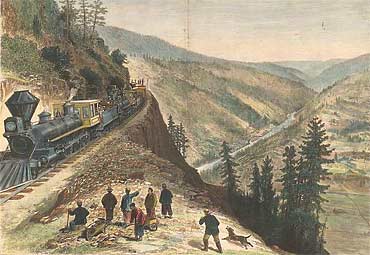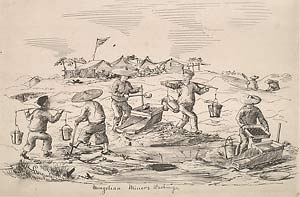UC Berkeley Press Release
Chinese in California exhibit opens
BERKELEY – A new exhibit at The Bancroft Library illustrates the Chinese experience starting in 1850, when many of them left their homeland in hopes of sharing the Gold Rush riches of "Gam Saan," or "Gold Mountain," as they called California.
 This handcolored print by Frank Leslie shows a train rounding the bend as Chinese railroad workers look on, with a view in the background of the south fork of the American River near Coloma, where gold was first discovered. (Robert B. Honeyman, Jr. Collection, 1878; courtesy the Bancroft Library) |
Once they arrived here, the immigrants panned for gold, worked in the mines, provided critical labor for construction of the transcontinental railroad through the Sierra, transformed mucky swamplands into fertile farmland, developed thriving fishing villages and claimed their place in California despite almost incessant efforts to exclude them.
"Chinese in California, 1850-1925: Between Two Worlds," is open through May 31.
Among the highlights of the exhibit are 13 small paintings by Charles Rogers that depict daily life on the streets of San Francisco's Chinatown before the bustling community's destruction by a 7.8 magnitude earthquake in 1906.
The era covered by the exhibit was marked by a state Supreme Court ruling that a white man charged with murder couldn't be convicted based on the testimony of a Chinese witness; adoption of a foreign miners' tax aimed primarily at Chinese and Mexican workers; the hanging of 15 Chinese in anti-Chinese riots in Los Angeles; and the passage and extension of the Chinese Exclusion Act barring Chinese laborers from entering the United States.
Much of the library's extensive materials relating to the Chinese American experience in the state reflect racist sentiments of the times, said Theresa Salazar, curator of The Bancroft's collection of western Americana and of this exhibit. But while the exhibit touches on this, Salazar's use of photos, paintings, newspapers, diaries, business records, official documents and other items focus primarily on Chinese Americans' achievements.
 In this pen and ink drawing titled "Mongolian Miners Washing" artist B. Stockqueler depicts gold miners using rockers, carrying pails and digging, as well as a camp in the distance. (Robert B. Honeyman, Jr. Collection, 1850s; courtesy the Bancroft Library) |
Chinese Americans contributed to the state's important mining operations, she said, and when they were excluded from them, they shifted to jobs as merchants and with the railroad.
"The western part of the transcontinental railroad could not have been built without that contribution. Their involvement with the development of agriculture in the state also was outstanding, and with fishing, they created communities along the West Coast that, in spite of obstacles, were very viable," Salazar said.
The Bancroft exhibit also notes the wide influence of Chinese Americans in California as evidenced in the flourishing wine regions where they excavated cellars, thriving service industries where they established restaurants and laundries, and the creation of tourism successes such as Monterey and San Francisco.
Although Chinese men greatly outnumbered Chinese women in California during the exhibit's time period, immigrants married, had families, founded schools and built temples. They also doted on their offspring, noted writer Robert Howe Flectcher in a book titled "Ten Drawings in Chinatown," published around 1898. He wrote, ". the streets reveal one very human trait, and that is the universal kindness and affection shown to their children."
The exhibit also features a stunning portrait of a mother and child, from a series of photographs taken by Clara Sheldon Smith from 1895-1911 in Marysville, which still boasts a large Chinese population.
A key section of The Bancroft's exhibit is devoted to San Francisco's Chinatown, the largest Chinese American community in the country, which built up around Portsmouth Plaza, the city's first public square and civic center. Adjoining the city's well-heeled Nob Hill neighborhood, Chinatown became prime city real estate.
After the 1906 earthquake, its residents were sent to refugee camps in the Richmond district, the Presidio and across the bay in Oakland - generally isolated from other camps of quake survivors, Salazar said. Chinese leaders firmly resisted efforts to relocate Chinatown, and they lobbied for reconstruction in a distinctive Oriental style to attract more business and visitors.
Several well-known photographers were drawn to Chinatown around the turn of the century, including Arnold Genthe, Carleton Watkins and I.W. Taber, whose black-and-white work is featured in the exhibit.
Salazar said much of The Bancroft's material about the Chinese in California was produced by "outsiders," such as the just-mentioned photographers and others like miner Timothy Coffin Osborn. In a journal entry for Dec. 26, 1850, Osborn wrote about a group of Chinese building a log cabin nearby: "They are mostly young men . and very polite towards us. I like to talk with them, and ask them hundreds of questions about their native land, for they are intelligent and one of them speaks good English."
The exhibit also includes the 1883 oral history of Kwang Ki-Chaou, who talked about his early life in China and emigration to the United States.
"Some of the images and documents and other artifacts are evidence that many California Chinese had settled here, despite official and legal discouragement," said William Wong, author of "Images of America: Oakland's Chinatown" (2004), and "Yellow Journalist: Dispatches from Asian America" (2001). Wong was among almost 300 visitors who previewed the exhibit before its opening on Monday.
"Thank goodness there is a Bancroft Library to house and display the California Chinese experience," Wong said.
"Chinese Americans are hungry to see their cultural history exhibited in an institution of the stature of UC Berkeley," said Sheryl Wong, a member of the UC Berkeley Foundation, who also attended the preview. The large preview turnout "shows the interest that people of diverse backgrounds have in the topic," she said.
Joyce Mar of the Chinese Historical Society of Southern California said she took special pleasure in the exhibit's paintings of early Chinatown, where her father lived before the 1906 earthquake. "Since no one took pictures in those days, it gave me a sense of what Chinatown looked like then," she said.
Mar's husband, Wing Mar, edited "Portraits of Pride," a book published late last year by the Chinese Historical Society of Southern California that documents the lives of 38 Chinese American men and women from the World War II era and their largely unknown accomplishments in science, medicine and education.
The exhibit is open Monday through Saturday 1-5 p.m.. The library will be closed April 23 and May 30. The Bancroft closes for seismic retrofit and renovation on June 1, moving to temporary quarters at 2121 Allston Way in downtown Berkeley.
The Bancroft shares a rich and extensive sampling of its Chinese American collection, along with materials from the campus's Ethnic Studies Library and the California Historical Society in San Francisco, on a special Library of Congress Web site at: http://bancroft.berkeley.edu/collections/chineseinca/index.html.

